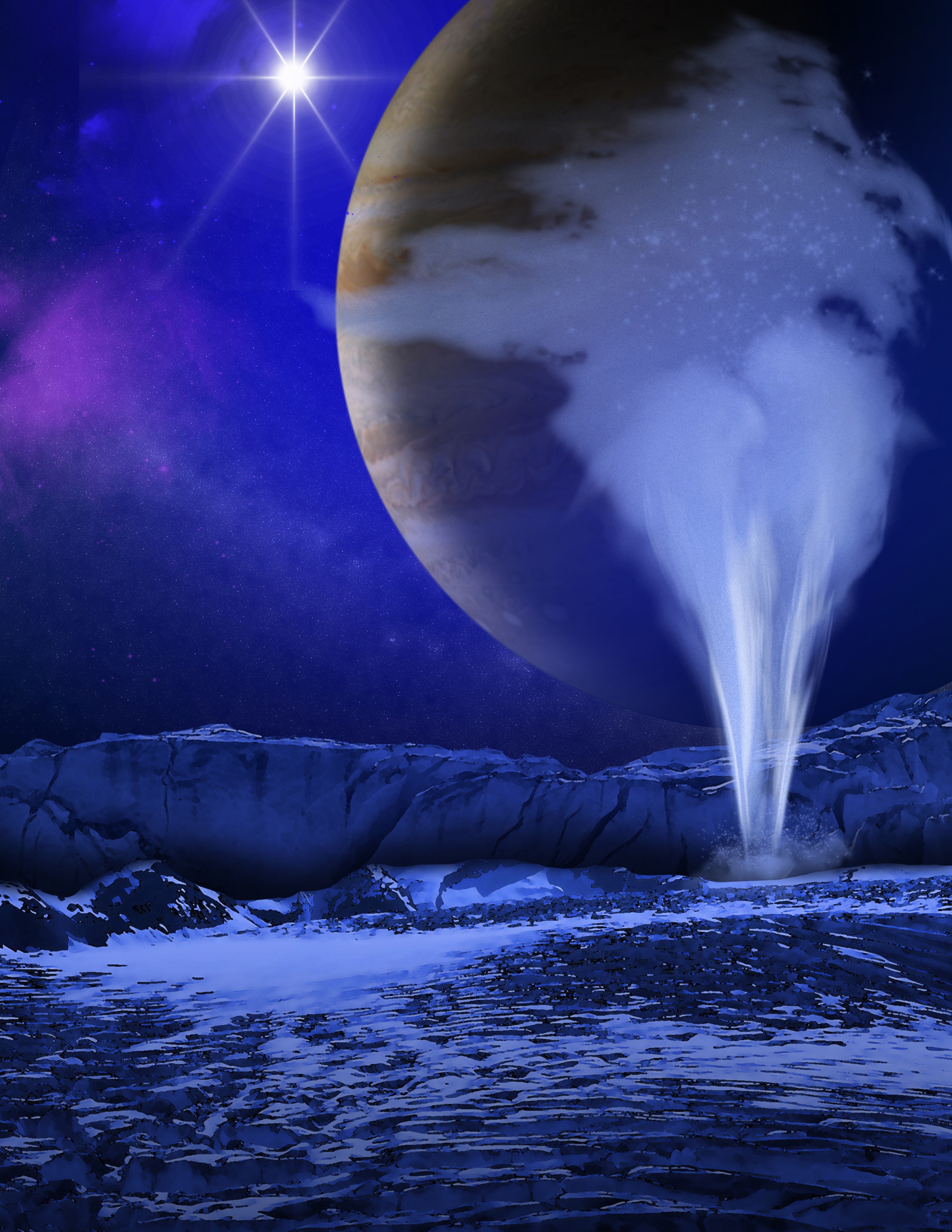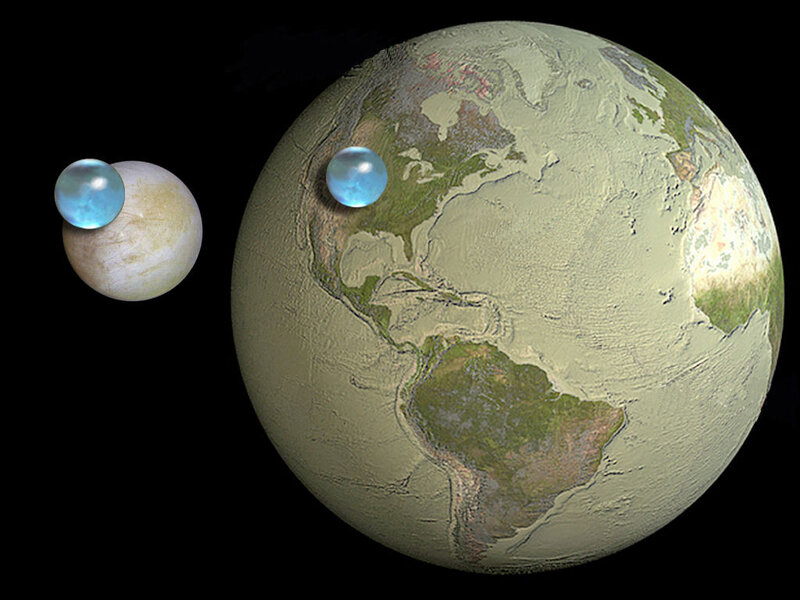Create a free profile to get unlimited access to exclusive videos, sweepstakes, and more!
New observations hint that Jupiter’s moon Europa erupts with water geysers (corrected)

Correction, and it's a big one: When I wrote this, I thought the conclusions based on the observations were much more solid than they were reported in a NASA press release. But after being alerted by a couple of astronomers, and looking things over again, I see that the idea that a plume of water from a geyser is not "confirmed" as I originally wrote, but more like "maybe." The detection by itself was marginally statistically significant, but was part of 16 other observations that showed nothing. I was thinking about the single observation taken alone, but when placed in context of the other observations the statistical significance drops. That means the likelihood of this observation being real — that is, that the light from a plume of water was definitely seen — is lower than I originally stated.
Think of it this way: If you have a box of 100 coins, shake it, and then count the number of coins that are heads you should get a number close to 50, but also likely to be 48 or 52. You get some random deviation from average. The more times you shake it and count, the more likely you are to get a single case where you get what looks like a significant change from average (like, say 70 heads and 30 tails). That's the difference here; if you shook the box once and got that big a swing you’d be right to at least suspect something was up, but if you got it after a lot of trials then you’d be more likely to think this is just an inevitable random swing (low probability events eventually happen if you give them enough chances). This example is something of an oversimplification, but that's the idea.
I apologize for this, and take the blame here! I should have been more careful when looking over the results.
In the end, my conclusion is that this observation is interesting, even provocative, but I would like to see a lot more observations done. If it's repeatable, and repeatable with statistical significance, then we're onto something. Until then, I think this belongs with the earlier observations I wrote about below, which indicated something might be happening, but we still can't be sure.
I've decided to leave my article as is, since correcting it would mean extensive changes. Instead I'll leave it up with this correction/warning, and let it stand as a cautionary tale. - Phil Plait, 19 Nov. 2019]
Astronomers have long suspected Jupiter’s moon Europa may have conditions underneath its surface that could support life. We’ve known for a long time that its surface is a shell of ice over an ocean of liquid water, but it’s been difficult to see that water directly. The ice shell is kilometers thick, and all the evidence we have is indirect.
It looks like that’s now changed: Astronomers have just announced the direct detection of water erupting from Europa in huge geysers!
The observations were made using the mammoth 10-meter Keck telescope. Keck can detect infrared light, far outside the colors our eyes can see, and this is critical: When water molecules are struck by sunlight, they can absorb it, vibrate (like weights on springs attached to each other) and re-emit that energy at specific wavelengths of infrared light.
The astronomers observed Europa from February 2016 to May 2017, looking for those wavelengths. Sixteen of those observations produced nothing out of the ordinary, but the 17th — on 26 April 2016 — they caught the right glow. The amount of infrared light they saw implied that about 2,100 tons of water had blasted out into space from beneath Europa’s surface. In liquid form that’s very roughly the volume of a large house. In this case, though, it was in the form of vapor, so occupied a lot more volume.
This is exciting! Europa is a little bit smaller than our own Moon, but the amount of liquid water inside Europa is more than all the oceans and rivers on Earth! The surface of the moon is clearly icy and riddled with cracks, but it’s been unclear if that water can make its way through that thick ice shell.
The culprit here is gravity. And when you’re talking about Jupiter, gravity is a big deal. Europa orbits Jupiter on a very slightly elliptical orbit, and that means sometimes it’s a little closer to Jupiter, and sometimes farther away. The gravity it feels from Jupiter changes over its 3.5-day orbit, and this winds up squeezing and compressing the moon. This generates huge amounts of friction inside Europa, which manifests as heat (like rubbing your hands together on a cold day warms them up). The heat melts the water ice, creating the subsurface ocean (this is exactly the same mechanism responsible for the geysers of water Cassini saw erupting from Saturn’s moon Enceladus).
The surface temperature is so cold, about -170° C on average, that any water there though is frozen into rock-hard ice. That’s why it’s been so hard to see the liquid water directly. Still, apparently, it can squeeze itself up through those cracks, and erupt in 200-kilometer-high geysers.
Evidence for these plumes has been building for a long time. The first observations of them, though not understood as such at the time, were from the Galileo spacecraft, which flew through a plume in 1997. Computer modeling in the day wasn’t good enough to figure out what the observations meant, but later analysis supported the idea the spacecraft had flown through a water geyser.
Then, in 2013, Hubble Space Telescope observations strongly implied water was erupting into space; it saw a molecule called OH-, which is what you get when ultraviolet light from the Sun breaks apart water molecules (that, plus a hydrogen atom). These observations looked pretty good, but OH- molecules can be formed in other ways. Water is the easiest and most likely way, so it’s pretty good evidence, but it’s still indirect.
These new observations show water directly. This happens often in science; you get a hint of something, so you keep looking, and as technology and software get better, your chances of confirming or negating that idea grow. In this case, things went in the positive direction. Hurray!
So what does this mean for life under Europa? It’s been a scientific possibility for a long time now, and to be honest, I don’t think too many scientists have any lingering doubts that the water ocean is there. The good news here is that now we have direct evidence for it. So it’s a step in the right direction.
The next step, though, is a giant leap: Europa Clipper, a NASA mission to the moon. Equipped with instruments that can take mapping images, thermal scans, ultraviolet spectra, magnetic readings, and more (a lot more), it’s a surveying mission that will orbit Europa and try to answer some of the biggest questions we have about the moon: How deep is the ocean? What other molecules are in there besides water (like, organic molecules)? What’s the geography of the surface like?
And, of course, is it possible the chemistry there is right for life to exist?
So yeah, this is all a very big deal. Clipper is being built now, and should launch to Jupiter in the middle of the next decade. It won’t be too long before we have more close-ups of this moon, and have a much better understanding of its surface… and what lies beneath.




























